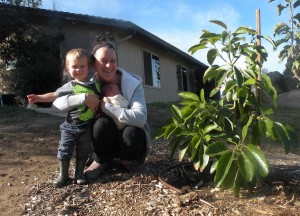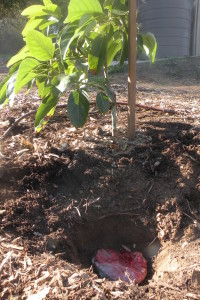For Cass, the choice of planting his placenta under a Fuerte avocado tree was obvious, but for Miles, born last week, the options felt overwhelming at times. First, we didn’t know if we were going to have a boy or girl. Before Miles was born we did decide that we would plant another avocado for a boy and then a different, sweeter type of fruit tree for a girl, but that was as far as we got.
When Miles surprised us and came four days before his due date, we had to quickly choose a specific avocado variety. They are innumerable; for avocados, every seed is slightly different from its parent, so every seed ever grown is unique, a different variety, like humans.
We considered Holiday (also called XX3), but it’s a runty tree, not auspicious for our son. We considered Pinkerton, but Ursula didn’t want our boy’s tree to have “pink” in the name.
We landed on Sharwil. It is a variety that originated in Australia, is widely grown in Hawaii, but is rare in California. The varietal name Sharwil is a union of the beginnings of the last names of the men who grew the first of these trees, Frank Sharpe and J.C. Wilson, according to the book “The Avocado: Botany, Production, and Uses.” It’s fruit is said to be similar to the Fuerte, with green skin and medium size, and friends whose opinions I trust say that Sharwil tastes great. That’s right, I’ve never tasted a Sharwil myself. But Miles has been a surprise from the moment he was born, so why not keep it going with his placenta tree?
A couple of other things that encouraged us to select Sharwil are the beauty of its foliage, which includes shinier, broader leaves than many other avocados, plus the fact that the fruit is ready to eat later than Fuertes. The Fuerte season starts in winter whereas the Sharwil season starts in spring. The Sharwil fruit is also reputed to have great “hang time.” For some in Southern California, the fruit remains on the tree, mature and ready for picking, all the way to December — Miles’s birthday. Maybe a yearly ritual can be eating the last Sharwils on Miles’s birthday.
Instead of placing the placenta directly beneath the tree, I buried it only a few inches under the soil and to the side. This is because avocados are not deep rooted; “80 percent of the feeder roots of mature avocado trees are in the top 6 inches of the soil,” says Gary Bender in the “California Master Gardener Handbook.”
Also, according to my own experience, last year I placed a pile of yard and food scraps beside Cass’s Fuerte and covered it with woodchips. Some months later I dug into the decomposing pile and found roots proliferating within it, feeding off of it. This is what I expect will happen among Miles’s Sharwil and his placenta.
You might also like to read:
“Miles and his placenta tree turn one, but one of them almost gets eaten by a gopher.”





How many fruit are you getting per year on your Sharwil? I planted one 1.5 years ago. Its my heathiest growing tree. I was a little concerned when you said your B types don’t produce as well.
Hi Monty,
This poor Sharwil got attacked by gophers multiple times and eventually I removed it and have planted a new one.
It’s true that B types don’t produce as well as A types for me, but that’s not to say that your Sharwil won’t produce very well for you. Much depends on the climate in your yard; specifically, you should get good production if you have temperatures during bloom where the average of nightly lows and daily highs is above 60 — above 65 is even better.